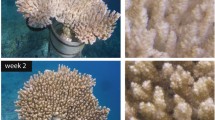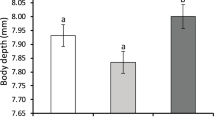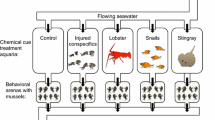Abstract
Understanding prey response to predators and their utilization of sensory cues to assess local predation risk is crucial in determining how predator avoidance strategies affect population demographics. This study examined the antipredator behaviors of two ecologically similar species of Caribbean coral reef fish, Coryphopterus glaucofraenum and Gnatholepis thompsoni, and characterized their responses to different reef predators. In laboratory assays, the two species of gobies were exposed to predator visual cues (native Nassau grouper predator vs. invasive lionfish predator), damage-released chemical cues from gobies, and combinations of these, along with appropriate controls. Behavioral responses indicate that the two prey species differ in their utilization of visual and chemical cues. Visual cues from predators were decisive for both species’ responses, demonstrating their relative importance in the sensory hierarchy, whereas damage-released cues were a source of information only for C. glaucofraenum. Both prey species could distinguish between native and invasive predators and subsequently altered their antipredator responses.




Similar content being viewed by others
References
Albins MA (2012) Effects of invasive Pacific red lionfish Pterois volitans versus a native predator on Bahamian coral-reef fish communities. Biol Inv, 1–15
Albins MA, Hixon MA (2008) Invasive Indo-Pacific lionfish Pterois volitans reduce recruitment of Atlantic coral-reef fishes. Mar Ecol Prog Ser 367:233–238
Albins M, Hixon M (2012) Worst case scenario: potential long-term effects of invasive predatory lionfish (Pterois volitans) on Atlantic and Caribbean coral-reef communities. Environ Biol Fish, 1–7
Albins MA, Lyons PJ (2012) Invasive red lionfish Pterois volitans blow directed jets of water at prey fish. Mar Ecol Prog Ser 448:1–5
Brown GE (2003) Learning about danger: chemical alarm cues and local risk assessment in prey fishes. Fish Fish 4:227–234
Brown GE, Magnavacca G (2003) Predator inspection behaviour in a characin fish: an interaction between chemical and visual information? Ethology 109:739–750
Chivers DP, Mirza RS, Bryer PJ, Kiesecker JM (2001) Threat-sensitive predator avoidance by slimy sculpins: understanding the importance of visual versus chemical information. Can J Zool 79:867–873
Cole K, Shapiro DY (1992) Gonadal structure and population characteristics of the protogynous goby Coryphopterus glaucofraenum. Mar Biol 113:1–9
Cote IM, Maljkovic A (2010) Predation rates of Indo-Pacific lionfish on Bahamian coral reefs. Mar Ecol Prog Ser 404:219–225
Cox JG, Lima SL (2006) Naivete and an aquatic-terrestrial dichotomy in the effects of introduced predators. Trends Ecol Evol 21:674–680
Creel S, Christianson D (2008) Relationships between direct predation and risk effects. Trends Ecol Evol 23:194–201
Cressler CE, King AA, Werner EE (2010) Interactions between behavioral and life-history trade-offs in the evolution of integrated predator-defense plasticity. Am Nat 176:276–288
Eggleston DB, Grover JJ, Lipcius RN (1998) Ontogenetic diet shifts in Nassau grouper: trophic linkages and predatory impact. Bull Mar Sci 63:111–126
Ferrari MCO, Chivers DP (2006) Learning threat-sensitive predator avoidance: how do fathead minnows incorporate conflicting information? Anim Behav 71:19–26
Fishelson L (1975) Ethology and reproduction of pteroid fishes found in the Gulf of Agaba (Red Sea), especially Dendrochirus brachypterus (Cuvier) (Pteroidae, Teleostei). Mar Ecol 39:635–656
Forrester GE, Steele MA (2004) Predators, prey refuges, and the spatial scaling of density-dependent prey mortality. Ecology 85:1332–1342
Forrester GE, Evans B, Steele MA, Vance RR (2006) Assessing the magnitude of intra- and interspecific competition in two coral reef fishes. Oecologia 148:632–640
Grosholtz ED, Ruiz GM, Dean CA, Shirley KA, Maron JL, Connors PG (2000) The impacts of a nonindigenous marine predator in a California bay. Ecology 81:1206–1224
Hartman EJ, Abrahams MV (2000) Sensory compensation and the detection of predators: the interaction between chemical and visual information. Proc R Soc Lond B 267:571–575
Helfman GS (1989) Threat-sensitive predator avoidance in damselfish-trumpetfish interactions. Behav Ecol Sociobiol 24:47–58
Helfman GS, Meyer JL, McFarland WN (1982) The ontogeny of twilight migration patterns in grunts (Pisces, Haemulidae). Anim Behav 30:317–326
Holmes TH, McCormick MI (2010) Smell, learn and live: the role of chemical alarm cues in predator learning during early life history in a marine fish. Behav Proc 83:299–305
Jones GP, McCormick MI (2002) Numerical and energetic processes in the ecology of coral reef fishes. In: Sale PF (ed) Coral reef fishes: dynamics and diversity in a complex ecosystem. Academic Press, San Diego, pp 221–240
Kim JW, Brown GE, Dolinsek IJ, Brodeur NN, Leduc AOHC, Grant JWA (2009) Combined effects of chemical and visual information in eliciting antipredator behaviour in juvenile Atlantic salmon Salmo salar. J Fish Biol 74:1280–1290
Knapp RA (2005) Effects of non-native fish and habitat characteristics on lentic herpetofauna in Yosemite National Park, USA. Biol Conserv 121:265–279
Larson JK, McCormick MI (2005) The role of chemical alarm signals in facilitating learned recognition of novel chemical cues in a coral reef fish. Anim Behav 69:51–57
Lesser MP, Slattery M (2011) Invasive lionfish causes a phase shift to algal dominated communities at mesophotic depths on a Bahamian coral reef. Biol Invasions 13:1855–1866
Lima SL (2002) Putting predators back into behavioral predator-prey interactions. Trends Ecol Evol 17:70–75
Lima SL, Dill LM (1990) Behavioral decisions made under risk of predation. Can J Zool 68:619–640
Marsh KE (2003) Pheromonal mediation of sex change in the bridled goby, Coryphopterus glaucofraenum, a protogynously hermaphroditic reef fish. Biology, Oxford, MS
Martin CW, Fodrie FJ, Heck KL Jr, Mattila J (2010) Differential habitat use and antipredator response of juvenile roach (Rutilus rutilus) to olfactory and visual cues from multiple predators. Oecologia 162:893–902
Mathis A, Vincent F (2000) Differential use of visual and chemical cues in predator recognition and threat-sensitive predator-avoidance responses by larval newts (Notophthalmus viridescens). Can J Zool 78:1646–1652
McCormick MI, Manassa R (2008) Predation risk assessment by olfactory and visual cues in a coral reef fish. Coral Reefs 27:105–113
Milano D, Lozada M, Zagarese HE (2010) Predator-induced reaction patterns of landlocked Galaxias maculatus to visual and chemical cues. Aquat Ecol 44:741–748
Miner BG, Sultan SE, Morgan SG, Padilla DK, Relyea RA (2005) Ecological consequences of phenotypic plasticity. Trends Ecol Evol 20:685–692
Mirza RS, Chivers DP (2001) Do chemical alarm signals enhance survival of aquatic vertebrates: An analysis of the current research paradigm. In: Marchalewska-Koj A, Lepri JJ, Muller-Schwarze D (eds) Chemical signals in vertebrates. Plenum Press, New York, pp 19–26
Mirza RS, Chivers DP (2003) Response of juvenile rainbow trout to varying concentrations of chemical alarm cue: response thresholds and survival during encounters with predators. Can J Zool 81:88–95
Mitchell MD, McCormick MI, Ferrari MCO, Chivers DP (2011a) Coral reef fish rapidly learn to identify multiple unknown predators upon recruitment to the reef. PLoS ONE 6(1):e15764
Mitchell MD, McCormick MI, Ferrari MCO, Chivers DP (2011b) Friend or foe? The role of latent inhibition in predator and non-predator labelling by coral reef fishes. Anim Cog 14:707–714
Morris JA, Akins JL (2009) Feeding ecology of invasive lionfish (Pterois volitans) in the Bahamian archipelago. Environ Biol Fish 86:389–398
Randall JE (1967) Food habits of reef fishes of the West Indies. Stud Trop Oceanogr 5:665–867
Sadovy YJ and Eklund AM (1999) Synopsis of biological information on Epinephelus striatus (Bloch 1972), the Nassau grouper and E. itajara (Lichtenstein 1822), the jewfish. NOAA-NMFS technical report 146
Schmitz OJ, Ovadia O, Krivan V (2004) Trophic cascades: the primacy of trait-mediated interactions. Ecol Lett 7:153–163
Scrimgeour GJ, Culp JM (1994) Feeding while evading predators by a lotic mayfly: linking short-term foraging behaviours to long-term fitness consequences. Oecologia 100:128–134
Shulman MJ, Ogden JC (1987) What controls tropical reef populations: recruitment of benthic mortality? An example in the Caribbean reef fish Haemulon flavolineatum. Mar Ecol Prog Ser 39:233–242
Sih A (1987) Predators and prey lifestyles: an evolutionary and ecological overview. In: Kerfoot WC, Sih A (eds) Predation: direct and indirect impacts on aquatic communities. University Press of New England, Hanover, pp 203–224
Sih A, Crowley P, McPeek M, Petranka J, Strohmeier K (1985) Predation, competition, and prey communities: a review of field experiments. Ann Rev Ecol Syst 16:269–311
Sih A, Petranka JW, Kats LB (1998) The dynamics of prey refuge use: a model and tests with sunfish and salamander larvae. Am Nat 132:463–483
Sih A, Bolnick DI, Luttbeg B, Orrock JL, Peacor SD, Pintor LM, Preisser E, Rehage JS, Vonesh JV (2010) Predator-prey naivete, anti-predator behavior, and the ecology of predator invasions. Oikos 119:610–621
Smith R (1989) The response of Asterropteryx semipunctatus and Gnatholepis anjerensis (Pisces, Gobiidae) to chemical stimuli from injured conspecifics, an alarm response in gobies. Ethology 81:279–290
Smith RJF, Lawrence BJ (1992) The response of a bumblebee goby, Brachygobius sabanus, to chemical stimuli from injured conspecifics. Env Biol Fish 34:103–108
Smith RJF, Smith MJ (1989) Predator-recognition Behaviour in Two Species of Gobiid Fishes, Asterropteryx semipunctatus and Gnatholepis anjerensis. Ethology 83:19–30
Smith RJF, Lawrence BJ, Smith MJ (1991) Cross-reaction to skin extract between two gobies, Asterropteryx semipunctatus and Brachygobius sabanus. J Chem Ecol 17:2253–2259
Stallings CD (2008) Indirect effects of an exploited predator on recruitment of coral-reef fishes. Ecology 89:2090–2095
Tricas TC (1989) Determinants of feeding territory size in the corallivorous butterflyfish, Chaetodon multicinctus. Anim Behav 37:830–841
Ward AJW, Mehner T (2010) Multimodal mixed messages: the use of multiple cues allows greater accuracy in social recognition and predator detection decisions in the mosquitofish, Gambusia holbrooki. Behav Ecol 21:1315–1320
Wisenden BD (2003) Chemically mediated strategies to counter predation. In: Collin SP, Marshall NJ (eds) Sensory processing in aquatic environments. Springer, New York, pp 236–251
Wisenden BD, Dye TP (2009) Young convict cichlids use visual information to update olfactory homing cues. Behav Ecol Sociobiol 63:443–449
Acknowledgments
The authors thank Cole Easson, Ashlei Evans, Sylvester Lee, and Caroline Williams for their help in all aspects of this study, both underwater and in the laboratory. We also thank the staff at the Perry Institute for Marine Science for their logistical support. Fish were collected under permits from the Bahamas Department of Marine Resources. All experimental methods were approved by and are in compliance with the guidelines of the Institutional Animal Care and Use Committee of the University of Mississippi. This research was supported in part by grant #NA16RU1496 to MS jointly funded by the National Oceanic and Atmospheric Administration and the National Institute for Undersea Science and Technology.
Author information
Authors and Affiliations
Corresponding author
Additional information
Communicated by K. D. Clements.
Rights and permissions
About this article
Cite this article
Marsh-Hunkin, K.E., Gochfeld, D.J. & Slattery, M. Antipredator responses to invasive lionfish, Pterois volitans: interspecific differences in cue utilization by two coral reef gobies. Mar Biol 160, 1029–1040 (2013). https://doi.org/10.1007/s00227-012-2156-6
Received:
Accepted:
Published:
Issue Date:
DOI: https://doi.org/10.1007/s00227-012-2156-6




